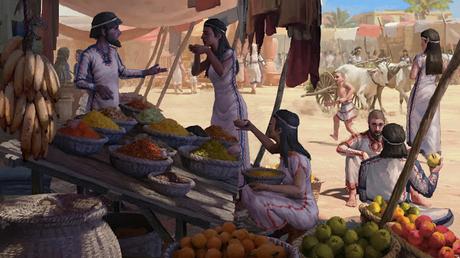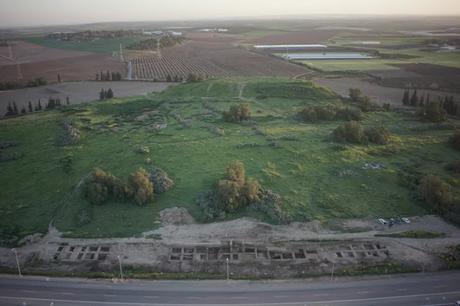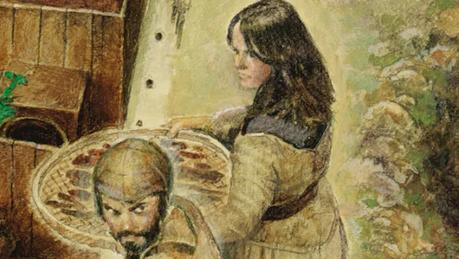
Soy and turmeric were already eaten in the Mediterranean region over 3000 years ago: Studies on teeth show that Southeast Asian spices and fruits were on the menu in Israel today.
The story of the Magi has long been more than a Christmas story for scientists: in addition to its symbolic role, your visit to Bethlehem reflects the flourishing long-distance trade during the Roman Empire: It supplied the eastern Mediterranean with exotic oils and resins from the Arab region Sea and more eastern places on earth.
But the history of long-distance trade is apparently much older than previously thought: New studies have shown that the ancient inhabitants of today's Israel ate fruits and spices that must have come from the deep south of Asia already 3,500 years ago.
A recent study of fossilized dental plaque from more than a dozen skeletons from the Middle Bronze Age to the Early Iron Age (about 1500-1100 B.C.) provided evidence that these people ate bananas, turmeric, and soybeans - all plants - during their lifetime which at that time could only have come to the Mediterranean region from far away South and East Asia.
The research results published in the specialist magazine PNAS thus complement existing art-historical and archaeological findings that have shown that imports from distant countries ranged from chickens to black pepper and vanilla from India and Indonesia.
It is the first comprehensive study of ancient tartar protein and plant debris of its kind using material from the ancient Middle East.

For a long time it was assumed that people sourced their food regionally and imported precious stones from distant countries, ”says Philipp Stockhammer, co-author of the study and archaeologist at the Ludwig Maximilians University in Munich. "But already in the Bronze Age the trade was similar to ours today, food was imported from all over the world."
Felt on the tartar
Tartar, i.e. old dental plaque that accumulates and hardens over the years, was considered relatively useless garbage in archeology until recently. During rehearsals, it was scraped off and disposed of. However, recent discoveries show that it was a mistake: tartar is a vast source of information that can be read from DNA to bacteria and proteins.
"If we stopped brushing our teeth now, archaeologists could still prove what we ate in 2000 years," says Stockhammer.

To find out what the people of the ancient Levant ate, an international team analyzed plaque from the teeth of 16 skeletons.
Some of them have been excavated in Megiddo, an ancient city-state also known by the biblical name Armageddon (derived from Har-Megiddo, Hebrew for a mountain of Megiddo). Megiddo flourished in the Bronze Age, which can be seen today from the type of graves.
"The country was rich and well connected," says Stockhammer, "but not a major player - nothing compared to Egypt or Mesopotamia." The tartar of Megiddo's teeth showed that the people there did not just eat a lot of grains and fruits such as dates.
The samples also contained traces of food from distant countries: soybeans and the bright orange spice turmeric - both plants from southern Asia that archaeologists had not suspected on the menu of people in the Mediterranean region.
"Although only a small number of samples have been taken and examined, things have already been found that you would never have expected," says Matthew Collins, an expert on ancient protein at the University of Copenhagen who was not involved in the study.
The researchers also examined tartar from the teeth of people who lived in a nearby settlement called Tel Erani around 1100 BC. Were buried. Archaeologists associate this place with the people known in the Bible as the Philistines.
The reason for the two different places: in Tel Erani the burials were rather simple. The researchers wanted to find out whether there would be less evidence of exotic imports here, in a comparatively poorer place.
The results were surprising, however: traces of sesame were also found in samples from Megiddo. Sesame oil, paste, and seeds are often found in Levantine cuisine today, but the plant actually comes from South Asia.
Also in the tomb of the Egyptian pharaoh Tutankhamun, which was built around 1400 BC. Archeologists have found sesame seeds. However, this was seen as an exception, and initially doubted whether sesame was already common in the local diet at that time.
The researchers made the most surprising discovery in the skeleton of a man around fifty who was buried in Tel Erani: they found a protein that triggers ripening in bananas. "Since [the burials of Tel Erani] are very modest and there is nothing to suggest that he belongs to an elite, one can assume that it was not the remains of a king who ate his first banana," says Stockhammer.
Make the invisible visible
So tartar is a valuable source of information in identifying foods such as spices and oils, which in most archaeological settings are rarely or not preserved at all. Because although these two types of food are already known as important goods of this time, “they are almost impossible to find in archaeological records,” says co-author Christina Warinner, paleogeneticist at Harvard University and at the Max Planck Institute for the History of Human History in Jena. “Our research shows the great potential of paleo protein analysis. With this method, we can find indications of food that would otherwise leave no traces. ”For example, rare sesame and soy oils and exotic fruits such as bananas. Tartar is an "incredibly exciting source".
Archaeological evidence of bananas is particularly difficult to find: the domesticated fruits are seedless and their soft flesh disintegrates quickly. It is therefore unlikely that whole banana trees were shipped to Megiddo. Instead, the people there might have imported and eaten dried banana chips - they can survive long voyages with ease.
Unlike animal DNA, milk proteins, or the more stable microscopic crystals found in the tough stems of grain, vegetable proteins are less likely to be preserved in tartar. This leaves the misleading impression that milk, meat, and porridge determined the diet in the past millennia.
In the new study, the researchers used a new method to analyze which proteins and plant residues from the diet were found in tartar. They spent significantly more time than in previous studies comparing the findings with known vegetable proteins.

The researchers believe it is likely that foods like sesame and bananas were eaten by other people they studied - but that the proteins in tartar were not included or have not persisted to this day. "Our results are just the tip of the iceberg," says Stockhammer. "The fact that only one person has evidence of banana consumption does not mean that only one person has eaten bananas - it just means that there is only one person for whom sufficient evidence has been found."
Since it is difficult to determine when the tartar formed in the dead person's life, it could meanwhile also be that the “banana eater” in Tel Erani was a trader or seafarer who ate the fruit while traveling in Asia before coming to the Shores of the Mediterranean died - which would be no less interesting.
Either way, the new results prove that trade stretched from China to the Mediterranean as early as the Bronze Age.
"Today that's not a big surprise," says Ayelet Gilboa, director of the Zinman Institute for Archeology at Haifa University. "In the past ten years, our knowledge of early long-distance trading has developed significantly."
Five years ago, for example, Gilboa published research that came from excavations not far from Megiddo: She had found jars with cinnamon remains. But at first, she was not believed. "People said it was impossible," said Gilboa. "Then as we dug deeper, we found more evidence, it was there all the time.
Just nobody bothered to look at it." Today there is a lot of evidence that goods that were already in use as early as the second millennium BC. were transported over great distances. "This shows that even back then, small companies were operating as part of a huge network."
Photo Credit: National Geographic

